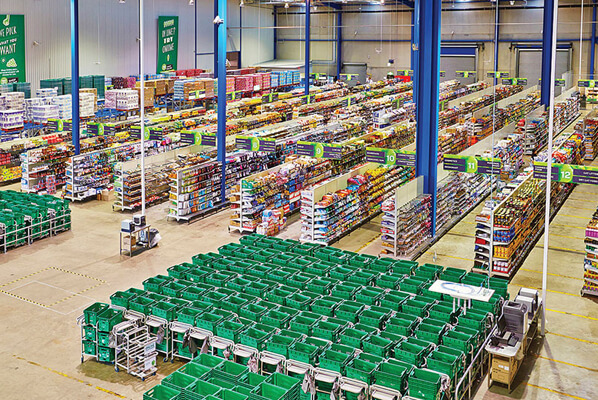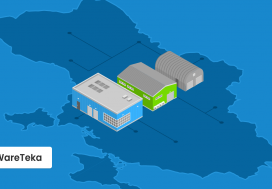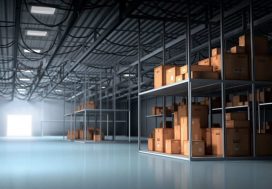
- Distribution centers instead of shopping malls
- Stores without shoppers
- Two as one: urban warehouse and pick-up point
- Conclusions: What are the urban warehousing logistics development prospects
As some business domains find it difficult to cope with the impact of lockdown, others, on the contrary, grow at an incredible speed. At the moment, eCommerce is at its height: by the projections of analytics, brick-and-mortar’s pace of transition to online has speeded up to 5 years.
Ukrainian eCommerce isn’t also staying away from global trends. Payoneer has reviewed more than 200.000 companies worldwide and rated counties with the most growing eCommerce. Thus, Ukraine got 6th place, overtaking Israel, India, Japan, and Vietnam. China, the USA, Hong Kong, South Korea, and Great Britain are at the top of the ranking.
But despite growing, the eCommerce domain has faced another problem. There are not enough urban warehouses in the Ukrainian logistics real estate market. Moreover, online retailers need to store double amounts of products in warehouses, as they can’t place the part of goods on the stores’ shelves. Lack of storing spaces is a global pattern.
In the article, we’ll show you 3 cases of how online retailers transform their warehouses to accommodate special urban logistics needs.
Distribution centers instead of shopping malls
Lockdown restrictions have a negative impact on the retail real estate market, as when authorities suppress visits to shopping malls, retailers’ profit has decreased. So, they couldn’t pay their rent.
Shopping malls were idle, as they couldn’t receive visitors. On the other hand, shopping malls have a huge advantage — premises are near to an end-consumer. And the transition to online has speeded up last-mile logistics (delivery from shops to customers) evolving.
The key element in last-mile logistics is delivery speed. For example, nowadays, consumers order foodstuff online more often. They expect orders to be delivered for at most 1 hour. An urban distribution center provides retailers with high delivery speed.

Amazon has been focusing on high delivery speed since its foundation. However, even such eCommerce giants are forced to expand distribution storing spaces during the pandemic.
In August 2020, American editions informed Amazon was planning to transform vacant shopping malls into distribution centers. The company engaged in negotiations with Simon Property Group, a commercial real estate operator.
It’s a great crisis response to transform idle shopping malls into Amazon warehouses. In this way, online retailers can make up shortfalls in the warehousing space expanding and speed up order processing and fulfillment.
Stores without shoppers
Everything old is new again. In the early 2000s, Sainsbury’s launched a new urban fulfillment center. It was the very first dark store. Back then, the conception failed to be reciprocated, as there was little demand.

In 2009, Tesco established its first store without shoppers. The mall was similar to the conception of Sainsbury’s. At a first sight, stores were no different from ordinary shopping points. Goods were still on the shelves. However, there were no customers in the store, only employees of the “warehouse shop” were there to process orders. The concept was called “dark store”. Nowadays, dark stores are in great demand among European consumers.
When the COVID-19 pandemic had come, dark stores became more popular than ever. The reason is that they are a great alternative to common urban warehouses.
For example, in 2020, Australian supermarket chain Woolworths temporarily transformed its 3 points of sales into dark stores. The company decided to do that due to lockdown restrictions when the demand for online shopping has increased. So, the online retailer could process orders faster and quickly deliver goods even in suburbs.
Despite dark stores being a new form for Ukrainian consumers, some companies have already begun to develop the direction. For example, in Kyiv, the online supermarket Cooker was opened in Kyiv. The company provides its customers with high delivery speed. It’s about 30 minutes to deliver goods across the capital and satellite-cities. Cooker has achieved great success thanks to 12 dark stores, which are located across all Kyiv areas.
It’s expected that when the pandemic ends, dark stores will be in great demand and become more popular.
Two as one: urban warehouse and pick-up point
Click-and-collect in retail has been evolving worldwide during the lockdown restrictions. The point is that customers can research items on a web-site, place their orders, and pay. Then, they should just visit a pick-up point at any time and take goods. Some American retailers even implement drive-up, when a customer comes to a pick-up point and collects an order in a car. It’s a convenient and great way to keep a social distance.

However, a retailer needs to find a warehouse for order processing and a place for visiting to develop a pick-up point. A distribution center has to be located near to customers.
In 2020, Ukrainian retailer Epicentr K has launched a new format, pick-up point with warehouses. So, customers order goods on the web-site, receive notices, and visit the point to collect goods.
The facility is equipped with a guest lounge area, TV set, children’s area, so visitors can wait for an order with comfort. Also, you can charge your smartphone, have a cup of coffee, and review the catalog with the assortment of the goods here.
The first floor is for visitors, but the second one is for employees. Other parts of the premise are equipped like a small warehouse. Storing space is 700 square meters. Large goods (furniture, for example) are stored in one zone, and small-scale commodities are stored in another zone. The warehouse is equipped with modern racking systems to maximize storage space.
To combine the pick-up point and warehouse is a great solution. Customers can receive their orders in the most convenient and safe way, and retailers can increase order processing.
Conclusions: What are the urban warehousing logistics development prospects
Although demand in eCommerce is growing rapidly, retailers should develop omnichannel. However, when a company begins transitioning online, it should consider leveraging more storage space (at least twice). Cause it can’t store commodities on the stores’ shelves. Demand in warehouses is increasing.
On the other hand, there is a lack of urban warehouses, so retailers transform their facilities. For example, Amazon, an eCommerce giant, engaged in negotiations with Simon Property Group, a commercial real estate operator. The online retailer was willing to transform idle shopping malls into Amazon’s warehouses in the USA. In this way, the company was planning to speed up last-mile deliveries.
One more exciting concept is dark stores, malls without visitors. Employees can process orders here. Dark Stores have been evolving in Europe since the early 2000s. However, the conception failed to be reciprocated at first. During the pandemic, when we need to follow restrictions, dark stores are a great solution for retailers. For example, Ukrainian online-supermarket Cooker has built 12 dark stores across Kyiv. So, the company delivers orders in 30 minutes.
The third case of the transformation is combining pick-up points and warehouses from Epicentr K. Here, visitors can receive their orders, and the second floor is equipped like a warehouse with modern automated equipment.
COVID-19 pandemic has just accelerated the evolution of urban warehousing logistics.




